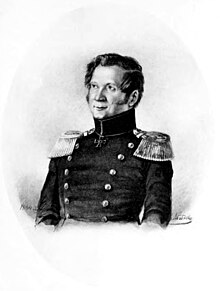Pavel Petrovich Anosov
This article needs additional citations for verification. (December 2016) |

Pavel Petrovich Anosov (
Early life
Anosov was the son of a petty clerk, and became an orphan at 13 years old. When his father died he left four young children as orphans: two older brothers, Peter and Pavel, and two younger sisters. The orphans took over the education of their maternal grandfather, mining official
The grandfather sent Pavel with his elder brother Peter to the St. Petersburg Mining Cadet Corps in 1810, during which time his brother Peter died. Pavel Anosov's skill at mathematics and science led him to early success.
In 1817 he completed his Mining corps (Mountain corps) training, and joined the state factories at Zlatoust as a trainee. He took care of his younger sisters, the youngest of whom was soon married. The other remained a spinster at the time of Paul Anosov's death, and remained gravely unwell at their home.
Career
After completion of the corps he worked in Zlatoust Mining District from 1817 to 1847:
- 1817–1819 – as a trainee;
- 1819–1821 – as a caretaker of "decorated department" at the Arms factory;
- 1821–1824 – as an assistant of the arms factory steward;
- 1824–1831 – as the controller of the arms factory;
- 1831–1847 – as the head of mining and director of the arms factory;
- 1847–1851 – as the head of the Altai Mountains plants, and civilian governor of Tomsk.
His civil ranks in the
Anosov received international attention for his writings on the manufacture of iron and his re-discovery of the secret of
Anosov was the first to use the microscope in studies into the structure of steel (1831), laying the foundation for the microscopic analysis of metals.
Anosov was elected a corresponding member of
See also
- Statue of Graf Vorontsov, Odessa
- Statue of Metallurgist Anosov, Zlatoust
- Statue of Yuriy Dolgorukiy, Moscow#The satellite-monuments
- SS Metallurg Anosov
References
- ^ Главацкий М., Дашкевич Л. (2005). "Павел Аносов - известный и неизвестный". Наука и жизнь.
- ^ a b c Златоустовский индустриальный колледж им. П. П. Аносова. "Некролог". Сын Отечества. 1851. Т. XII. Декабрь. С. 38—42. Archived from the original on 15 March 2008. Retrieved 9 March 2008.
- ^ Златоуст >> Памятник П. П. Аносову.
